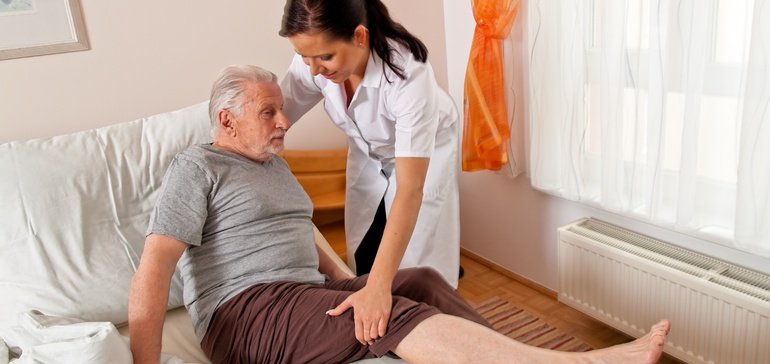
Dive Brief:
- Nursing homes lost about 18,000 jobs last month while home healthcare services gained the same amount, according to June’s jobs report from the Bureau of Labor Statistics. Some industry officials say it’s a trend accelerated by the COVID-19 pandemic after nursing homes were brutally hit earlier this year given their vulnerable populations.
- No visitor policies at nursing homes meant to stem the spread of the virus are another reason for increased demand in home health services, Vicki Hoak, executive director of industry trade group Home Care Association of America told Healthcare Dive.
- Despite the recent uptick, there are still fewer jobs in home healthcare services than during the same time last year, similar to nursing homes. Bill Dombi, president of industry group National Association for Homecare and Hospice, said canceled elective surgeries have weakened demand from patients getting hip, joint or knee replacements “which are a material segment of the population of patients served in homecare.”
Dive Insight:
Home healthcare encompasses a wide variety of services, from personal care aides who assist patients with daily tasks, to home health aides able to provide medical care, including rehabilitation services after surgeries.
Many of the services they provide, though, can serve as an alternative to placing family members in a long-term care facility, which have been hotbeds for the virus.
On Tuesday, the American Health Care Association and National Center for Assisted Living sent a letter to governors warning of imminent outbreaks at nursing homes and assisted living facilities again, given the major spikes in new cases in several states across the U.S.
It’s unclear exactly what percent of current COVID-19 related deaths have occurred at nursing homes, though the Centers for Disease Control and Prevention said their congregate nature and population of older adults with underlying conditions put them at high risk.
Nursing home jobs have been on the decline over the past year, and lost 37,000 jobs in May, according to BLS, before shedding another 18,000 in June.
And while there aren’t as many home healthcare jobs today as there were a year ago, they’ve been on the uptick since the beginning of the pandemic, unlike nursing homes. Some industry group leaders said demand for those services are likely to continue as the baby boomer population ages.
“We are seeing a change in demand,” said Dombi of the National Association for Homecare and Hospice, a trade group that represents home health, hospice and personal care providers including some of the biggest like Kindred Care at Home and Amedisys. “But it’s a bit of a mixed bag.”
As COVID-19 cases continue to climb across the country, more people are tapping into homecare services in lieu of outpatient visits, Dombi said. The services are also becoming an increasingly attractive alternative to nursing homes.
“Hospitals are full of COVID patients and many nursing homes are not even admitting new patients at this point, so they have really one place to go and that’s home,” Dombi said.
According to a 2019 LexisNexis analysis, Louisville, Kentucky-based Kindred Care at Home along with Amedisys and LCH Group, both Louisiana-based, are some of biggest home healthcare companies that stand to benefit from the trend.
Brookdale Senior Living is one of the largest senior living operators, with more than 800 properties. Winter Park, Florida-based Holiday Retirement is next with 259 facilities.
Hoak of the Home Care Association of America, said her group is also seeing increased demand for personal care services at home. She said certified nursing assistants working in nursing homes are finding home health jobs more attractive, as they can spend more time taking care of fewer patients.
According to BLS, home health and personal care aides receive short, on-the-job training and make a median salary of $ 24,060 per year.
Home health aides who provide medical care are often licensed practical and vocational nurses who must complete a state-approved education program, typically a year long. Their median salary is $ 47,480.
Most of the staff in nursing homes are either nursing assistants or orderlies, who make a median salary of $ 29,640.
BLS estimates home health aide and personal care aide jobs are projected to grow 36% from 2018 to 2028, much faster than the average for all occupations, and faster than the 9% growth rate expected for nursing home jobs. Licensed practical and vocational nurse jobs are expected to grow 11%.
If the trend continues as expected, filling jobs will be difficult, Hoak said, noting challenges to find workers even before the COVID-19 crisis as the population ages.
“More of these people who are getting older are baby boomers, and baby boomers do not like anyone to tell them what to do. They’re saying they want to stay home and have someone come into my home, and we won’t have enough people to care for them. So we’ve got to take a serious look at wages, benefits.”
The American Health Care Association/National Center for Assisted Living also told Healthcare Dive the pandemic is worsening a crisis in long-term care that preceded the pandemic.
It noted a “considerable toll fighting this virus has on staff members, the tremendous cost required to protect and care for residents, and the lack of adequate support from public health officials.”
